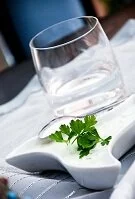Staple Foods
Albania doesn't have any true staple foods, although there is a meat and a vegetable in nearly every dish. Along the coasts fish is often times substituted for the meats.
Regional Variations & Specialties
Pace Koke: sheep head soup
Kukurec: sheep organs in stomach casing
Dining Etiquette

Tzatziki & rakia
Albanians enjoy their food, but they don't take it so seriously that there is a whole list of rules associated with it. In fact, dining is much like Albanian life, as time takes a back seat to conversation and the food is meant to be enjoyed with good company.
The strictest dining rules come not in the eating process, but in the circumstances surrounding the actual meal. It is good policy to bring a gift if dining in a local's home and the best gifts are items from your home country or gifts for their children (if they have any). As most Albanians are Muslim, don't give a gift of alcohol; although most Albanian Muslims do consume alcohol; it is not wise to guess and be incorrect. The second important thing to note is that if you're dining in a restaurant with business partners, or even just locals you'll likely see that there is an odd "payment structure" in that your host will most likely insist on paying for the first meal, but the next time you meet you are expected to reciprocate the favor.
Eating does have its rules as well. Generally speaking though, these are very standard to the rest of Europe: let your host show you your seat, eat in the continental style (knife in the right hand, fork in the left), etc. It is also likely that you are offered raki, the local alcohol. Not trying this can be offensive so do take a sip, but be careful as it can be deceivingly strong.